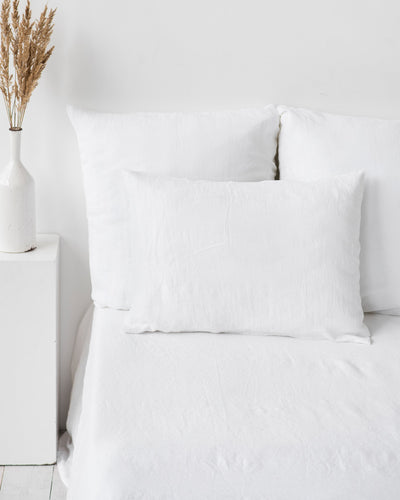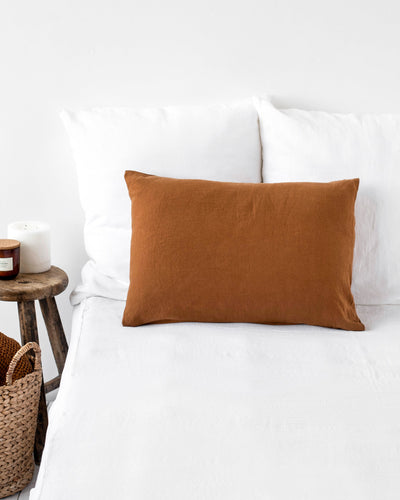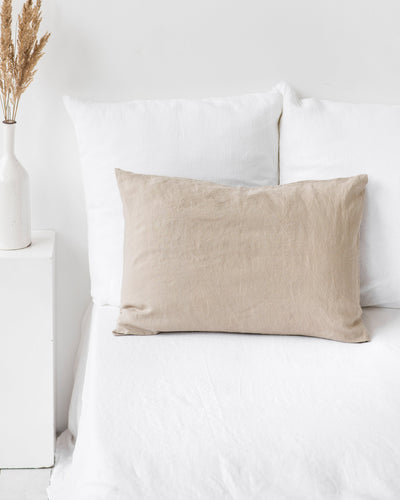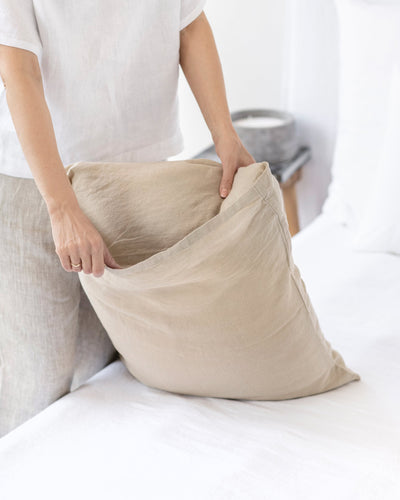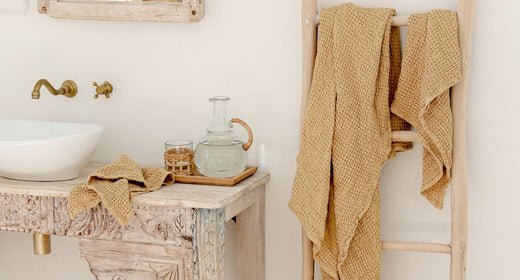How to Get Blood Out of Linen (Fresh & Dried Stains)

Key Takeaways
-
Acting quickly and using cold water to blot fresh blood stains is key to preventing them from setting into linen fabrics.
-
Different stain removal methods work best for different types of linen and stain conditions—salt solution for all linens, hydrogen peroxide for light-colored fabrics, and baking soda paste for gentle cleaning and odor removal.
-
Avoid hot water, rubbing, chlorine bleach, and dryer heat to protect linen fibers and ensure stains don’t set permanently.
A sudden nosebleed, a scraped knee, or even a small cut while shaving are all common scenarios in which you may suddenly notice a bright red stain. It may be your favorite linen dress or your tailored linen suit. You’re panicking just thinking about the delicacy of linen.
What if we told you there’s a way to remove these stains safely and still have a well-maintained linen? This guide will walk you through safe, simple, and effective ways to remove both fresh and dried blood stains from linen so that your fabrics stay clean and look their best.
The Golden Rule: Act Fast and Use Cold Water
Whether you’re treating blood stains on your everyday linen clothing or cozy linen pajamas, the golden rule is to act quickly and use cold water.
As soon as you notice the blood stain, gently blot it with a clean cloth dampened in cold water, but don’t rub it. If you act quickly, you prevent the blood from drying and setting into the fabric.
Cold water helps to dissolve the proteins in blood by making it easier to lift. On the other hand, hot water causes the blood proteins to stick to the linen fibers and makes the stain permanent.
How to Remove Fresh Blood from Linen: 3 Effective Methods

Fresh blood stains are much easier to remove if you treat them right away. Below are three simple and effective methods that work great with linen without damaging the fabric itself. Each method uses common household items and focuses on lifting the stain gently before it sets permanently on the fabric.
Method 1: The cold water and salt solution
This method works best for quickly and gently lifting any linen. Cold water prevents the stain from setting, while salt helps to break down blood proteins gently and naturally.
For this method, you’ll need the following:
-
Cold water
-
Table salt
-
A clean white cloth or towel
What to do step-by-step:
-
In a bowl, mix two teaspoons of salt with 1 cup of cold water. Stir this until the salt dissolves completely.
-
Dip the cloth into the solution and start gently blotting the stain. Don’t rub the stain, as this can spread it or damage the linen.
-
Reapply the solution and continue blotting until the stain starts to lift.
-
Rinse the area thoroughly with cold water to remove salt residue.
-
Let the fabric air dry completely before inspecting it further.
-
Remember, the sooner you treat it, the more effective this method will be.
Method 2: The hydrogen peroxide technique (for light-colored linen)
This method is ideal for removing stubborn stains on light-colored fabrics. Hydrogen peroxide can act as a mild bleaching agent and disinfectant by breaking down the blood proteins. However, it should be used with caution.
Warning: First, test this solution in a hidden area of the fabric to ensure it doesn’t cause any discoloration or damage.
For this method, you’ll need the following:
-
3% hydrogen peroxide
-
Clean cloth or paper towel
-
Cold water
What to do step-by-step:
-
Apply a small amount of hydrogen peroxide directly to the stain.
-
Let it sit for 5 to 10 minutes. You’ll notice a fizzing reaction as the peroxide breaks down the stain.
-
Gently blot with a clean cloth to absorb the stain and avoid scrubbing.
-
Rinse thoroughly with cold water to remove any remaining peroxide.
-
Air dry and repeat if necessary.
-
Remember to only use this method on white or very light-colored linen to avoid bleaching.
Method 3: The baking soda paste
Baking soda removes stains while being soft on delicate linen, making this method ideal for mild stains and safe for most linen types. It also neutralizes odors and refreshes the fabric.
For this method, you’ll need the following:
-
Baking soda
-
Cold water
-
Spoon or cloth for application
What to do step-by-step:
-
Mix 1 part baking soda with two parts cold water to create a smooth paste.
-
Apply the paste directly onto the stained area by covering it completely.
-
Let it sit for 30-60 minutes to allow the baking soda to break down the blood slowly.
-
Gently blot with a damp cloth to remove the paste and loosened stain.
-
Rinse thoroughly with cold water and let it air dry.
Tackling Dried Blood Stains on Linen

Dried blood stains may be more difficult, but the right approach can make it possible to remove them. Start by soaking the stained linen in cold water to loosen the dried blood. This pre-treatment can break down the stain before moving on to the full process.
Step-by-step process for dried blood
Follow this step-by-step guide to loosen and lift the dried blood stains effectively:
-
Soak the fabric
Fill a basin with cold water and add a mild detergent or solution of 1 part white vinegar to 2 parts cold water. Let the linen soak for 30 to 60 minutes so that the dried blood can soften.
-
Gently agitate the fabric
After soaking, lightly rub the stained area between your fingers or use a soft cloth to loosen the stain. Be careful not to fray the linen fibers, and try to be more gentle.
-
Apply a spot treatment
For stains that are difficult to remove, use a method from the fresh stain section, like hydrogen peroxide for light fabrics or baking soda paste for all linen types. Let it sit for 15 to 30 minutes, then blot it gently, and finally rinse with cold water.
-
Put it into the laundry as usual
Wash the linen with a mild detergent in cold water. Avoid the dryer until the stain is completely gone, as heat may make it permanent.
What to Avoid When Getting Blood Out of Linen
To protect your linen and make sure the blood stain doesn’t permanently set there, keep these important tips in mind:
-
Don’t use hot water
Hot water can cause the proteins in blood to set into the fabric, which makes the stain much more difficult to remove.
-
Don’t rub the stain vigorously
Rubbing can damage the delicate linen fibers and spread the stain by setting it deeper into the fabric.
-
Don’t use chlorine bleach (especially on colored or natural linen)
Chlorine bleach can weaken linen fibers and cause permanent damage or yellowing, particularly on dyed or untreated fabrics.
-
Don’t put the linen in the dryer until the stain is completely gone
Heat from the dryer can set any remaining blood residue, which is almost impossible to remove later.
-
Don’t use abrasive scrubbers or brushes
These can wear down the linen, especially if you use it repeatedly in the same spot.
-
Don’t delay treatment
The longer the blood sits on the linen, the harder it will be to remove it. Treat the stain as soon as possible for the best results.
Post-Treatment Care for Your Linen

Once the blood stain has been treated and mostly lifted, it’s essential to follow tips on how to wash linen and how to dry it in order to preserve the fabric.
-
Wash linen gently in cold water
Put your treated linen item in the washing machine and choose a gentle or delicate cycle with cold water only. Use a mild detergent that is linen-safe, and avoid harsh chemicals or bleach-based products. If you decide to wash it by hand, gently swish the fabric in a basin of cold water with detergent, then rinse thoroughly. For best results, follow proper guidelines on how to wash linen sheets to maintain fabric quality.
-
Check the linen before drying
After washing, carefully check the stained area to see whether it’s still faintly visible. If it is, do not dry the linen in the dryer. Repeat your stain removal method instead.
-
Air-dry the linen
Lay the linen flat on a clean towel or hang it to air dry naturally, but away from direct sunlight if it’s a colored or dyed fabric. Additionally, avoid using a dryer until you’re sure the stain is completely gone. Heat can permanently set even the faintest stains.
Wrapping Up
Removing blood stains from linen may seem like a lot of work, but the right techniques and a bit of patience can make the entire process easier. The most important thing is to act quickly and always use cold water. Never use hot water, as it can set the stain permanently.
Whether you’re using a simple salt solution, hydrogen peroxide, or a baking soda solution, make sure you gently blot and maintain it correctly after the treatment to make a real difference.
With these proven methods and the right practice, you’re set to remove even the toughest stains. Next time an accident happens, you’ll definitely know what to do without panic and with lots of confidence.
Looking to refresh your linen collection? Explore MagicLinen’s beautiful range of linen clothing, bedding, and home essentials to bring natural comfort and timeless style into your everyday life.
Frequently Asked Questions (FAQs)
Can I use the same methods for all types of linen?
This may not always be possible as some types of linen require different methods. For example, delicate or colored linen may require gentle and cold-water methods with color-safe stain removers to avoid any damage or fading.
Is it possible to remove a blood stain that has already been through the dryer?
Yes, but it may be harder. Soak the fabric with an enzyme cleaner or hydrogen peroxide, and then launder it again.
How to get period blood out of linens?
Rinse linen with cold water, apply enzyme cleaner or hydrogen peroxide, and then wash in cold water.
How do I get blood out of linen sheets?
Use a clean, white cloth dampened with cold water and then gently press it onto the stain to get rid of the blood. Make sure you don’t rub it to avoid spreading the stain further into the sheets.
How do I get blood out of white linen?
Use cold water and hydrogen peroxide to get blood out of white linen for a bleaching effect, and then wash them on a cold cycle.
How to remove blood stains from linen suits?
Blot your linen suit gently with cold water, dab with mild soap or diluted hydrogen peroxide, and then take it to a dry cleaner if needed.
 Vereinigte Staaten
Vereinigte Staaten
